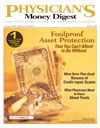Avoid Pitfalls of Performance Measurement
Instinctively, we think that weshould regularly measure the performanceof our funds and portfoliosand, depending on the results,take the necessary actions. But measuringportfolio performance frequently andchanging investment strategy based onthe short-term performance results canbe counterproductive, even dangerous,because these measurements are essentiallymeaningless. The following threefactors are primarily responsible for ourmisjudgments: market noise, our inabilityto make proper risk adjustments, andthe inadequacy of benchmarks.
Blocking Out the Noise
Short-term investment performancemostly measures market noise. Based onresearch, stock prices are considered tobe made up of a large random noisecomponent superimposed on a muchsmaller underlying long-term growthcomponent. This means that the stockmarket, mutual funds, and your portfoliocan be up or down significantly in aquarter or a year because of the noisecomponent. But that will have almost noeffect on long-term return.
It does not make sense to switchstocks or funds based on their performanceover a few quarters or years,because the short-term performance differencesmost likely reflect differences inthe noise components and provide noreliable information about which stockor fund will do better in the long run.
Even the long-term performance oftwo investors—or funds—can be reliablycompared only after proper risk adjustment,because if one of the investorstakes a lot more risk, then they maycome out ahead, just by luck. Unfortunately,we cannot reliably measurerisk or adjust performances for risk tomake fair comparisons. Wall Street andthe academic world have developed anumber of risk measurement tools, butthey often give a false sense of precision.
Viewing Risk and Benchmarks
The importance of risk adjustmentwas clearly demonstrated in the bubbleperiod of the late '90s. At that time, fundsfrom companies like Janus were doingspectacularly well by taking huge risksthat were not being properly measuredand reflected in their performance measurements.Investors, who switched hundredsof billions of dollars to these fundsfrom conservative lower-risk funds thatwere trailing the high flyers significantly,ultimately learned a very expensive lesson.Even holding index funds did notshelter people from the carnage, becausethey also got very risky—but the standardrisk measures did not capture that.
It has now become an accepted practiceto measure performances againstbenchmarks. The underlying logic is thatthis gets around the need to make riskadjustments because the benchmarkmeasures the performance of similarinvestments. This approach is an improvement,but still full of pitfalls.
The primary justification for buyingany actively managed fund is that it willperform better than its benchmark in thelong run. This performance of suchfunds will inevitably vary significantlyfrom a benchmark from period to period.Unfortunately, this is not well understood,and investors tend to flee fromfunds that underperform their benchmarksfor a few quarters or years. Thishas forced many active fund managers tobecome closet indexers and imitate themarket index in order to achieve similarresults. Such closet index funds are notworth buying because if you want performanceclose to the quarter-by-quarterperformance of the benchmark, you canget it at a much lower cost by simplybuying the corresponding index fund. Agood active fund's superiority can be seenonly in long-term performance.
Whether you are selecting an investmentmethod or a fund, or hiring amoney manager, do research up front toconvince yourself that the investmentmethod or the manager's investmentapproach is based on sound, objectiveresearch and has stood the test of time.After that, be a long-term investor andmeasure performance on a rolling 5-yearor longer basis. Except when somethingseems drastically wrong, do not keepmaking changes based on even annualperformance measurements. Your objectiveis to capture the underlying long-termgrowth component of stocks andnot to be buffeted by the noise componentthat dominates the short term.
Chandan Sengupta, author of The OnlyProven Road to Investment Success (JohnWiley; 2001) and Financial Modeling UsingExcel and VBA (John Wiley; 2004), currentlyteaches finance at the Fordham UniversityGraduate School of Business and consults with individualson financial planning and investment management. He welcomesquestions or comments at chandansen@aol.com.
